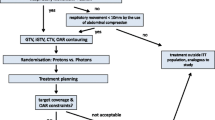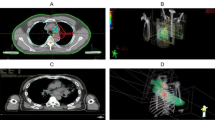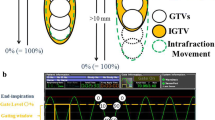Opinion statement
Non-small cell lung cancer (NSCLC) accounts for 85% of new lung cancer cases and has 5-year survival rates ranging from 92% in early-stage disease to as low as 13% in locally advanced cases. Radiation therapy is a key component in the treatment repertoire for NSCLC, where it is currently used alone or in combinations with chemotherapy and surgery. Despite the broad use of modern photon radiation techniques, as many as 25% of patients experience isolated locoregional recurrences, and toxicity has been proven to be a limiting factor in many cases. Proton beam therapy (PBT) has emerged as a potential solution to improve upon clinical outcomes in both early-stage and locally advanced disease. The proton beam allows for a sharp dose build-up and drop-off, which is particularly important in lung cancer where nearby structures include the heart, spinal cord, esophagus, and uninvolved lung. There are now numerous studies showing dosimetric advantages of PBT in early and locally advanced NSCLC, particularly in the heart and lung doses. Randomized data comparing clinical outcomes between proton and photon radiation are limited to a small number of studies. Despite early results suggesting improvements or at least comparable outcomes with PBT, the most recent randomized comparisons have failed to show significant differences in toxicity and local control between photon and proton therapy. As newer PBT techniques (e.g., intensity-modulated proton therapy) are increasingly utilized, more dramatic improvements in tumor control and toxicity may be demonstrated. It is also important to recognize that there may be certain subpopulations in which the benefits of proton therapy are greater, such as central early-stage tumors, previously irradiated tumors, and locally advanced tumors, while others may best be treated with traditional photon techniques. As immunotherapy becomes more prevalent in the treatment of NSCLC, improving local control and limiting the toxicity contributed by radiation will be increasingly important. The unique dosimetric advantages of PBT may allow for tumor dose escalation while maintaining normal tissue doses to improve local control, or treating the tumor to the standard dose while decreasing normal tissue doses to improve toxicity. Finally, given the high costs of proton therapy, where low insurance approval rates have limited trial enrollment, it will be important to determine the overall cost-benefit ratio.
Similar content being viewed by others
References and Recommended Reading
Papers of particular interest, published recently, have been highlighted as: • Of importance •• Of importance
Siegel RL, Miller KD, Jemal A. Cancer statistics, 2018. CA Cancer J Clin. 2018;68:7–30.
Macdonald OK, Kruse JJ, Miller JM, Garces YI, Brown PD, Miller RC, et al. Proton beam radiotherapy versus three-dimensional conformal stereotactic body radiotherapy in primary peripheral, early-stage non-small-cell lung carcinoma: a comparative dosimetric analysis. Int J Radiat Oncol Biol Phys. 2009;75(3):950–8.
Register SP, Zhang X, Mohan R, Chang JY. Proton stereotactic body radiation therapy for clinically challenging cases of centrally and superiorly located stage I non-small-cell lung cancer. Int J Radiat Oncol Biol Phys. 2011;80(4):1015–22.
Berman AT, Teo BK, Dolney D, et al. An in-silico comparison of proton beam and IMRT for postoperative radiotherapy in completely resected stage IIIA non-small cell lung cancer. Radiat Oncol. 2013;8:144.
Higgins KA, O’connell K, Liu Y, et al. National cancer database analysis of proton versus photon radiation therapy in non-small cell lung cancer. Int J Radiat Oncol Biol Phys. 2017;97(1):128–37.
Wang XS, Shi Q, Williams LA, Komaki R, Gomez DR, Lin SH, et al. Prospective study of patient-reported symptom burden in patients with non-small-cell lung cancer undergoing proton or photon chemoradiation therapy. J Pain Symptom Manag. 2016;51(5):832–8.
Nantavithya C, Gomez DR, Wei X, Komaki R, Liao Z, Lin SH, et al. Phase 2 study of stereotactic body radiation therapy and stereotactic body proton therapy for high-risk, medically inoperable, early-stage non-small cell lung cancer. Int J Radiat Oncol Biol Phys. 2018;101(3):558–63.
Bush DA, Cheek G, Zaheer S, Wallen J, Mirshahidi H, Katerelos A, et al. High-dose hypofractionated proton beam radiation therapy is safe and effective for central and peripheral early-stage non-small cell lung cancer: results of a 12-year experience at Loma Linda University Medical Center. Int J Radiat Oncol Biol Phys. 2013;86(5):964–8.
Wisnivesky JP, Bonomi M, Henschke C, Iannuzzi M, Mcginn T. Radiation therapy for the treatment of unresected stage I-II non-small cell lung cancer. Chest. 2005;128(3):1461–7.
Fang LC, Komaki R, Allen P, Guerrero T, Mohan R, Cox JD. Comparison of outcomes for patients with medically inoperable stage I non-small-cell lung cancer treated with two-dimensional vs. three-dimensional radiotherapy. Int J Radiat Oncol Biol Phys. 2006;66(1):108–16.
Grills IS, Mangona VS, Welsh R, Chmielewski G, McInerney E, Martin S, et al. Outcomes after stereotactic lung radiotherapy or wedge resection for stage I non-small-cell lung cancer. J Clin Oncol. 2010;28(6):928–35.
Chang JY, Senan S, Paul MA, Mehran RJ, Louie AV, Balter P, et al. Stereotactic ablative radiotherapy versus lobectomy for operable stage I non-small-cell lung cancer: a pooled analysis of two randomised trials. Lancet Oncol. 2015;16(6):630–7.
Timmerman R, Mcgarry R, Yiannoutsos C, et al. Excessive toxicity when treating central tumors in a phase II study of stereotactic body radiation therapy for medically inoperable early-stage lung cancer. J Clin Oncol. 2006;24(30):4833–9.
Onishi H, Shirato H, Nagata Y, Hiraoka M, Fujino M, Gomi K, et al. Hypofractionated stereotactic radiotherapy (HypoFXSRT) for stage I non-small cell lung cancer: updated results of 257 patients in a Japanese multi-institutional study. J Thorac Oncol. 2007;2(7 Suppl 3):S94–100.
Onishi H, Araki T, Shirato H, Nagata Y, Hiraoka M, Gomi K, et al. Stereotactic hypofractionated high-dose irradiation for stage I nonsmall cell lung carcinoma: clinical outcomes in 245 subjects in a Japanese multiinstitutional study. Cancer. 2004;101(7):1623–31.
Chang JY, Liu H, Balter P, Komaki R, Liao Z, Welsh J, et al. Clinical outcome and predictors of survival and pneumonitis after stereotactic ablative radiotherapy for stage I non-small cell lung cancer. Radiat Oncol. 2012;7:152.
Welsh J, Amini A, Ciura K, Nguyen N, Palmer M, Soh H, et al. Evaluating proton stereotactic body radiotherapy to reduce chest wall dose in the treatment of lung cancer. Med Dosim. 2013;38(4):442–7.
Chang JY, Komaki R, Wen HY, de Gracia B, Bluett JB, McAleer MF, et al. Toxicity and patterns of failure of adaptive/ablative proton therapy for early-stage, medically inoperable non-small cell lung cancer. Int J Radiat Oncol Biol Phys. 2011;80(5):1350–7.
Chang JY, Zhang W, Komaki R, Choi NC, Chan S, Gomez D, et al. Long-term outcome of phase I/II prospective study of dose-escalated proton therapy for early-stage non-small cell lung cancer. Radiother Oncol. 2017;122(2):274–80.
Hatayama Y, Nakamura T, Suzuki M, Azami Y, Ono T, Yabuuchi T, et al. Clinical outcomes and prognostic factors of high-dose proton beam therapy for peripheral stage I non-small-cell lung cancer. Clin Lung Cancer. 2016;17(5):427–32.
• Chi A, Chen H, Wen S, Yan H, Liao Z. Comparison of particle beam therapy and stereotactic body radiotherapy for early stage non-small cell lung cancer: a systematic review and hypothesis-generating meta-analysis. Radiother Oncol. 2017;123(3):346–54 Meta-analysis on proton beam therapy (PBT) and SBRT for early-stage NSCLC showing OS and PFS were significantly improved for PBT on univariate analysis and for local control on multivariate analysis.
Chang JY, Jabbour SK, De ruysscher D, et al. Consensus statement on proton therapy in early-stage and locally advanced non-small cell lung cancer. Int J Radiat Oncol Biol Phys. 2016;95(1):505–16.
Aupérin A, Le Péchoux C, Rolland E, et al. Meta-analysis of concomitant versus sequential radiochemotherapy in locally advanced non-small-cell lung cancer. J Clin Oncol. 2010;28(13):2181–90.
Ahn JS, Ahn YC, Kim JH, Lee CG, Cho EK, Lee KC, et al. Multinational randomized phase III trial with or without consolidation chemotherapy using docetaxel and cisplatin after concurrent chemoradiation in inoperable stage III non-small-cell lung cancer: KCSG-LU05-04. J Clin Oncol. 2015;33(24):2660–6.
Antonia SJ, Villegas A, Daniel D, et al. Overall survival with durvalumab after chemoradiotherapy in stage III NSCLC. NEJM. 2018. https://doi.org/10.1056/NEJMoa1809697.
Bradley JD, Paulus R, Komaki R, Masters G, Blumenschein G, Schild S, et al. Standard-dose versus high-dose conformal radiotherapy with concurrent and consolidation carboplatin plus paclitaxel with or without cetuximab for patients with stage IIIA or IIIB non-small-cell lung cancer (RTOG 0617): a randomised, two-by-two factorial phase 3 study. Lancet Oncol. 2015;16(2):187–99.
Nguyen QN, Ly NB, Komaki R, Levy LB, Gomez DR, Chang JY, et al. Long-term outcomes after proton therapy, with concurrent chemotherapy, for stage II-III inoperable non-small cell lung cancer. Radiother Oncol. 2015;115(3):367–72.
• Chang JY, Verma V, Li M, et al. Proton beam radiotherapy and concurrent chemotherapy for unresectable stage III non-small cell lung cancer: final results of a phase 2 study. JAMA Oncol. 2017;3(8):e172032 Prospective phase II trial for proton therapy plus chemotherapy for unresectable stage III NSCLC showing improved 5-year survival (29%) compared to historical controls and with promising local control and toxicity rates.
Hatayama Y, Nakamura T, Suzuki M, Azami Y, Ono T, Yamaguchi H, et al. Preliminary results of proton-beam therapy for stage III non-small-cell lung cancer. Curr Oncol. 2015;22(5):e370–5.
Oshiro Y, Okumura T, Kurishima K, Homma S, Mizumoto M, Ishikawa H, et al. High-dose concurrent chemo-proton therapy for stage III NSCLC: preliminary results of a phase II study. J Radiat Res. 2014;55(5):959–65.
•• Liao Z, Lee JJ, Komaki R, et al. Bayesian adaptive randomization trial of passive scattering proton therapy and intensity-modulated photon radiotherapy for locally advanced non-small-cell lung cancer. J Clin Oncol. 2018;36(18):1813–22 Highest-level evidence available directly comparing proton and photon radiation. Phase II design looking at PBT vs. IMRT for locally advanced NSCLC. Showed comparable levels of pneumonitis and local control with improved lung and heart doses in the proton group.
Radiation Therapy Oncology Group. Comparing photon therapy to proton therapy to treat patients with lung cancer. https://clinicaltrials.gov/ct2/show/study/NCT01993810.
Douillard JY, Rosell R, De Lena M, et al. Impact of postoperative radiation therapy on survival in patients with complete resection and stage I, II, or IIIA non-small-cell lung cancer treated with adjuvant chemotherapy: the adjuvant Navelbine International Trialist Association (ANITA) Randomized Trial. Int J Radiat Oncol Biol Phys. 2008;72(3):695–701.
Robinson CG, Patel AP, Bradley JD, DeWees T, Waqar SN, Morgensztern D, et al. Postoperative radiotherapy for pathologic N2 non-small-cell lung cancer treated with adjuvant chemotherapy: a review of the National Cancer Data Base. J Clin Oncol. 2015;33(8):870–6.
Herskovic A, Mauer E, Christos P, Nagar H. Role of postoperative radiotherapy in pathologic stage IIIA (N2) non-small cell lung cancer in a prospective nationwide oncology outcomes database. J Thorac Oncol. 2017;12(2):302–13.
Billiet C, Decaluwé H, Peeters S, Vansteenkiste J, Dooms C, Haustermans K, et al. Modern post-operative radiotherapy for stage III non-small cell lung cancer may improve local control and survival: a meta-analysis. Radiother Oncol. 2014;110(1):3–8.
Lally BE, Zelterman D, Colasanto JM, Haffty BG, Detterbeck FC, Wilson LD. Postoperative radiotherapy for stage II or III non-small-cell lung cancer using the surveillance, epidemiology, and end results database. J Clin Oncol. 2006;24(19):2998–3006.
Remick JS, Schonewolf C, Gabriel P, Doucette A, Levin WP, Kucharczuk JC, et al. First clinical report of proton beam therapy for postoperative radiotherapy for non-small-cell lung cancer. Clin Lung Cancer. 2017;18(4):364–71.
Curran WJ, Paulus R, Langer CJ, Komaki R, Lee JS, Hauser S, et al. Sequential vs. concurrent chemoradiation for stage III non-small cell lung cancer: randomized phase III trial RTOG 9410. J Natl Cancer Inst. 2011;103(19):1452–60.
Brooks ED, Sun B, Feng L, et al. Association of long-term outcomes and survival with multidisciplinary salvage treatment for local and regional recurrence after stereotactic ablative radiotherapy for early-stage lung cancer. JAMA Network Open. 2018;1(4):e181390.
Cetingoz R, Arican-Alicikus Z, Nur-Demiral A, Durmak-Isman B, Bakis-Altas B, Kinay M. Is re-irradiation effective in symptomatic local recurrence of non small cell lung cancer patients? A single institution experience and review of the literature. J BUON. 2009;14:33–40.
Ebara T, Tanio N, Etoh T, Shichi I, Honda A, Nakajima N. Palliative re-irradiation for in-field recurrence after definitive radiotherapy in patients with primary lung cancer. Anticancer Res. 2007;27:531–4.
McAvoy S, Ciura K, Wei C, Rineer J, Liao Z, Chang JY, et al. Definitive reirradiation for locoregionally recurrent non-small cell lung cancer with proton beam therapy or intensity modulated radiation therapy: predictors of high-grade toxicity and survival outcomes. Int J Radiat Oncol Biol Phys. 2014;90:819–27. https://doi.org/10.1016/j.ijrobp.2014.07.030.
McAvoy SA, Ciura KT, Rineer JM, et al. Feasibility of proton beam therapy for reirradiation of locoregionally recurrent non-small cell lung cancer. Radiother Oncol. 2013;109:38–44. https://doi.org/10.1016/j.radonc.2013.08.014.
Chao HH, Berman AT, Simone CB 2nd, et al. Multi-institutional prospective study of reirradiation with proton beam radiotherapy for locoregionally recurrent non-small cell lung cancer. J Thorac Oncol. 2017;12:281–92. https://doi.org/10.1016/j.jtho.2016.10.
Ho JC, Nguyen QN, Li H, Allen PK, Zhang X, Liao Z, et al. Reirradiation of thoracic cancers with intensity modulated proton therapy. Pract Radiat Oncol. 2018;8(1):58–65.
Author information
Authors and Affiliations
Corresponding author
Ethics declarations
Conflict of Interest
Shane Mesko has received compensation from Oscar Healthcare for service as a consultant.
Daniel Gomez has received research funding from Merck, Bristol-Myers Squibb, and AstraZeneca, and has received compensation from Varian, Driver, US Oncology, and RefleXion for service as a consultant.
Human and Animal Rights and Informed Consent
This article does not contain any studies with human or animal subjects performed by any of the authors.
Additional information
This article is part of the Topical Collection on Lung Cancer
Rights and permissions
About this article
Cite this article
Mesko, S., Gomez, D. Proton Therapy in Non-small Cell Lung Cancer. Curr. Treat. Options in Oncol. 19, 76 (2018). https://doi.org/10.1007/s11864-018-0588-z
Published:
DOI: https://doi.org/10.1007/s11864-018-0588-z




